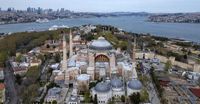On the afternoon of October 2, 2025, Istanbul—Turkey’s bustling metropolis of over 15 million—was rocked by a magnitude 5.3 earthquake, sending a wave of panic through the city and its neighboring provinces. According to the Turkish Disaster and Emergency Management Authority (AFAD), the quake struck at 2:55 p.m. local time, its epicenter located in the southern Marmara Sea, just off the coast of Marmaraereglisi in Tekirdag.
The tremor, which the Kandilli Observatory and Earthquake Research Institute also measured at 5.3 magnitude and a depth of about 12 kilometers (7 miles), was felt not only in Istanbul but in surrounding regions including Bursa, Yalova, and Tekirdag. The Turkish Earthquake Monitoring Institute reported a slightly lower magnitude of 5.19 but confirmed the impact across various regions, including the heart of Istanbul.
As buildings shook, panic quickly set in among residents. Eyewitnesses described scenes of confusion as people rushed from homes, schools, and workplaces, seeking safety in the open. One resident told Reuters that the quake "created a state of panic among residents," as the tremor rattled buildings throughout the city.
In the immediate aftermath, Istanbul’s famously congested streets became even more gridlocked. According to reporting by Anadolu Agency, many people abandoned their routines and flooded the city’s roads with private vehicles, hoping to reach loved ones or simply get away from tall buildings. The result was a rapid spike in traffic congestion, with vehicles struggling to move along major arteries such as the D-100 highway and the TEM motorway. The entrances to the 15 July Martyrs Bridge and the Fatih Sultan Mehmet Bridge saw particularly heavy congestion, while the Eurasia Tunnel, a vital link beneath the Bosphorus, continued to operate smoothly.
On the European side, gridlock stretched from Zincirlikuyu to Beylikdüzü along the D-100 highway heading toward Edirne. In the other direction, traffic jams started in Beylikdüzü and extended all the way to the 15 July Martyrs Bridge, passing through Cevizlibağ, Haliç, and Mecidiyeköy. The TEM Highway’s connection points at Basın Ekspres Street and Haramidere were also choked with cars. Meanwhile, on the Asian side, drivers in Üsküdar, Kadıköy, Ataşehir, and Ümraniye faced the same fate. Istanbul Metropolitan Municipality’s traffic data painted a stark picture: congestion reached 71% on the European side, 60% on the Asian side, and 67% overall—numbers that underscore just how quickly daily life can grind to a halt in this megacity.
Despite the chaos on the roads, air travel was largely unaffected. The Sabiha Gökçen Airport Authority (HEAŞ) reported that, after thorough inspections of the terminal, apron, taxiways, and runways, "no negative conditions were found." Their official statement reassured the public: "Our airport operations continue uninterrupted." Istanbul Airport, the city’s other major hub, also confirmed that flights resumed promptly after a brief pause for safety checks. According to Demiroren News Agency, air traffic at both airports was only briefly halted to allow for runway inspections, and no disruptions were reported.
As for the human toll, the Istanbul governor's office stated that there were no casualties or significant material damage reported. However, the psychological impact was clear. Twelve people sought help for panic attacks, and five others were treated for sprains caused by the rush to safety. In Marmaraereglisi, primary and secondary schools were evacuated as a precaution, according to Demiroren News Agency. CCTV footage showed crowds pouring out of buildings—testament to the prevailing anxiety that lingers in a city all too familiar with seismic risk.
Turkey’s Interior Minister, Ali Yerlikaya, took to social media to calm nerves and provide updates. "AFAD and all relevant institutions have begun field inspections," he wrote, emphasizing the government’s swift response. Authorities continued to assess the situation into the evening, ready to take any necessary measures should aftershocks or hidden damage emerge.
For Istanbulites, the day’s events were a stark reminder of the city’s vulnerability. Istanbul sits atop a complex web of fault lines, and earthquakes are an ever-present threat. The memory of the catastrophic twin earthquakes in southeastern Turkey on February 6, 2023—when more than 50,000 people lost their lives—remains fresh in the nation’s collective consciousness. That disaster, with both quakes measuring over magnitude 7 and affecting 11 provinces, underscored the importance of preparedness and rapid emergency response.
Yet, as of October 2, 2025, Istanbul had been spared the worst. No casualties, no significant material damage—just a city shaken, both literally and figuratively. The Turkish Disaster and Emergency Management Authority confirmed that, at least for now, the situation was under control. "No reports of casualties or significant material damage were reported as of October 2, 2025," an official statement read, echoing the relief felt by many.
Still, the quake’s psychological impact lingers, particularly in a city where millions live in high-rise apartment blocks and commute through crowded streets and tunnels. The day’s events sparked renewed conversations about building safety, emergency preparedness, and the need for continued vigilance. For some, the traffic jams and brief airport delays were a minor inconvenience; for others, the panic attacks and evacuations were a stark reminder of the city’s fragility.
As the sun set over the Bosphorus, Istanbul’s streets slowly began to clear. Public transport resumed its usual rhythm, and the city’s airports hummed back to life. Authorities promised continued monitoring, and field inspections pressed on. For now, life in Istanbul goes on—shaken, perhaps, but undeterred. The city’s resilience, tested once again, held firm in the face of nature’s unpredictable power.




